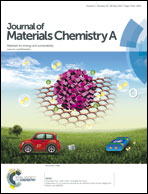Confined synthesis of ultrafine Ru–B amorphous alloy and its catalytic behavior toward selective hydrogenation of benzene†
Abstract
How to control the size and morphology of metal nanocatalysts is of vital importance in enhancing their catalytic performance. In this work, uniform and ultrafine Ru–B amorphous alloy nanoparticles (NPs) supported on titanate nanosheets were fabricated via a confined synthesis in titanate nanotubes (TNTs) followed by unwrapping the tube to sheetlike titanate (TNS) (denoted as Ru–B/TNS), which exhibit excellent catalytic performance toward the selective hydrogenation of benzene to cyclohexene (yieldcyclohexene: 50.7%) without any additives. HRTEM images show the resulting Ru–B NPs are highly dispersed on the titanate nanosheets (particle size: 2.5 nm), with a low Ru–Ru coordination number revealed by EXAFS. Moreover, XPS demonstrates the surface-enriched B element and a strong electron transfer from B to Ru, which facilitates the formation and desorption of cyclohexene on the Ru active-sites, accounting for the significantly enhanced catalytic behavior. The surfactant-free confined synthesis and additive-free catalytic system make the Ru–B/TNS catalyst a promising candidate for the selective hydrogenation of benzene.


 Please wait while we load your content...
Please wait while we load your content...